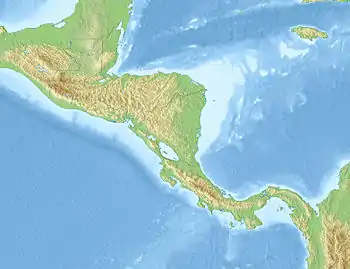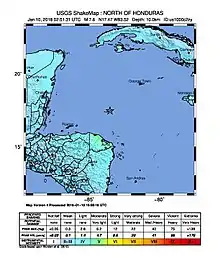 Belmopan Tegucigalpa | |
| UTC time | 2018-01-10 02:51:33 |
|---|---|
| ISC event | 611634051 |
| USGS-ANSS | ComCat |
| Local date | January 9, 2018 |
| Local time | 08:51:31 PM CST |
| Magnitude | 7.5 Mww |
| Depth | 19.0 km (11.8 mi) |
| Epicenter | 17°28′08″N 83°31′12″W / 17.469°N 83.520°W |
| Type | Strike-slip |
| Areas affected | Honduras Guatemala Belize Cayman Islands |
| Max. intensity | VII (Very strong) |
| Casualties | None |

On 9 January 2018, at approximately 8:51 p.m. local time (02:51 10 January UTC), a magnitude 7.5 earthquake struck in the Yucatán Basin of the Caribbean Sea, 44 kilometres (27 mi) east of Great Swan Island off the coast of Honduras.[1] The earthquake was felt across Central America, and rattled windows in Tegucigalpa.[2] The earthquake was also felt in the Cayman Islands.[3]
Tsunami advisories were issued for certain areas by the U.S. Tsunami Warning Center. They were later cancelled after further monitoring.[4] No tsunami was generated since the earthquake was an almost pure strike-slip on a near vertical plane, producing little upward movement of the sea floor that would cause a large displacement of water.[5]
Earthquake
The earthquake occurred at a depth of around 10 kilometres (6.2 mi) on a transform fault zone known as the Swan Islands Transform Fault in the Cayman Trough, where it forms part of the boundary between the North American Plate and the Caribbean Plate.[1] The area just to the west also produced a large earthquake in 2009 that measured 7.3 on the moment magnitude scale.[6] According to a finite fault model created by the U.S. Geological Survey, the earthquake generated a maximum slip of 24 meters in a compact rupture zone. Three sub-events were discovered during the rupture process, the third of which, occurred at a velocity exceeding that of the shear wave. Propagating at 5 km/s, faster than the shear wave velocity of 4 km/s, the event is classified as a supershear earthquake.[7]
Damage
No major damage was reported. However some homes suffered cracks in walls.[8]
Tsunami
A tsunami was observed with maximum heights of 0.4 m (1.3 ft) in Roatan Island, Honduras.[9] A 0.2 m (0.66 ft) surge was observed in George Town, Cayman Islands.[9]
See also
References
- 1 2 "M 7.5 – 44km E of Great Swan Island, Honduras". United States Geological Survey. 9 January 2018. Retrieved 9 January 2018.
- ↑ Palencia, Gustavo (9 January 2018). "Strong quake in Caribbean Sea shakes Honduras, Mexico and Belize, no tsunami". Reuters. Retrieved 9 January 2018.
- ↑ "Earthquake sparks tsunami scare". 11 January 2018.
- ↑ "Magnitude 7.6 quake hits in Caribbean north of Honduras". Associated Press. 9 January 2018. Retrieved 9 January 2018.
- ↑ "2018 Swan Islands earthquake tsunami". Stack Exchange Network. Retrieved 10 January 2018.
- ↑ Graham, Shannon E.; Demets, Charles; Deshon, Heather R.; Rogers, Robert; Maradiaga, Manuel Rodriguez; Strauch, Wilfried; Wiese, Klaus; Hernandez, Douglas (2012). "GPS and seismic constraints on the M = 7.3 2009 Swan Islands earthquake: Implications for stress changes along the Motagua fault and other nearby faults". Geophysical Journal International. 190 (3): 1625–1639. Bibcode:2012GeoJI.190.1625G. doi:10.1111/j.1365-246X.2012.05560.x.
- ↑ Chuang Cheng; Dun Wang (2020). "Imaging the rupture process of the 10 January 2018 MW7.5 Swan island, Honduras earthquake". Earthquake Science. 33 (4): 194–200. Bibcode:2020EaSci..33..194C. doi:10.29382/eqs-2020-0194-03. S2CID 241109747.
- ↑ "7.6 Honduras earthquake, a near miss". temblor.net. 10 January 2018.
- 1 2 "Tsunami Event: HONDURAS". ngdc.noaa.gov.
External links
- The International Seismological Centre has a bibliography and/or authoritative data for this event.